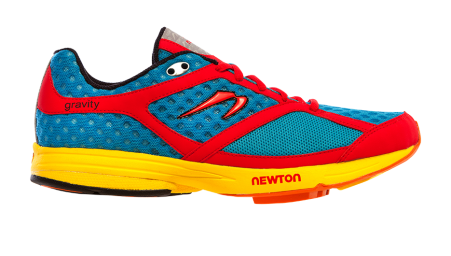Do Newton’s Forefoot Lugs Improve Running Economy?

Small study finds slight gain in runners unaccustomed to the shoes.
The “actuator lugs” in the forefoot of Newton running shoes provided an average boost of 1% in running economy for runners who hadn’t worn the shoes before, in a study published in Footwear Science.
Researchers at Sacred Heart University in Connecticut had 12 experienced runners do four 6-minute treadmill runs at what they called “submaximal” pace. For two of the short runs, the runners ran in conventional running shoes. For the other two, they wore Newtons. The shoes’ distinguishing feature is the lugs that protrude from the area of the outsole under the metatarsal heads.
During the four runs, the researchers measured the participants’ running economy, or how much oxygen they consumed at a given pace. On average, when wearing the Newtons, the runners were about 1% more economical. In theory, a gain in running economy should mean being able to run a given pace with less effort, or to run a faster pace with the same effort previously needed to run a slower pace.
Australian sport podiatrist Craig Payne makes two important points about the study in his blog Running Research Junkie.
First, as with almost all study findings, the 1% improvement in running economy is a group average; that’s different than saying that all 12 runners experienced a 1% improvement in running economy. In this small study, running economy improved for 10 of the participants when they wore Newtons, stayed the same for one, and got worse for one.
“We are seeing this more and more in the response of individuals to different technologies in running shoes,” Payne notes. That is, as with so many things in running, what works for one runner might not help another, and often, the only way to find out is to try the technique or technology in question.
Second, writes Payne, “The study was also an acute intervention and the differences reported may or may not be applicable to those who are habituated to the lugs.” In other words, it’s possible that the average improvement might not continue to occur if the runners were to regularly run in Newtons.
Potentially related to the above point, it’s worth noting that the test runs were only 6 minutes long. Many runners who have experimented with unfamiliar footwear over the last few years have felt early in a run like the shoes are helping them run with better form. But many runners have also felt that as fatigue sets in, old movement patterns take over, and they’re unable to sustain what feels like better form over the course of a run.
The videos below show our reviews of two Newton models.
— written By
Scott Douglas (www.runnersworld.com)
Where to find Newton Running Shoes: AMAZON
